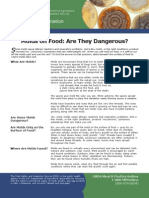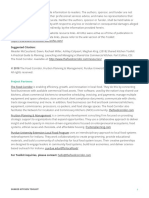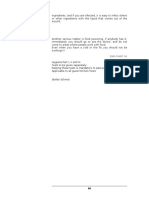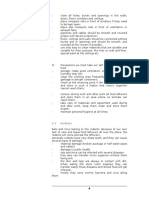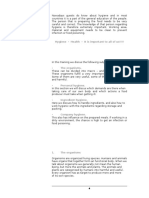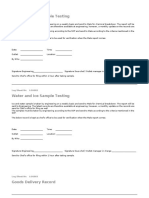0 ratings0% found this document useful (0 votes)
20 viewsBlank Fig
Blank Fig
Uploaded by
mohamed.mauroofMold and fungus are commonly found in foods. While some molds are visible, most are microscopic and hidden inside foods. Even if only a small section of mold is visible, the roots have likely spread throughout the food. Consuming moldy foods risks ingesting toxic waste and poisons produced by molds that can cause serious illness. Simply cutting off moldy sections does not ensure safety, as the entire contaminated food should be discarded. Mold spreads easily through microscopic spores carried by air. Both mold and its poisons can survive cooking temperatures, so heating contaminated foods is not a reliable way to eliminate the health risks. While some molds like penicillin have useful medical applications, others like those found in peanuts
Copyright:
© All Rights Reserved
Available Formats
Download as PDF, TXT or read online from Scribd
Blank Fig
Blank Fig
Uploaded by
mohamed.mauroof0 ratings0% found this document useful (0 votes)
20 views1 pageMold and fungus are commonly found in foods. While some molds are visible, most are microscopic and hidden inside foods. Even if only a small section of mold is visible, the roots have likely spread throughout the food. Consuming moldy foods risks ingesting toxic waste and poisons produced by molds that can cause serious illness. Simply cutting off moldy sections does not ensure safety, as the entire contaminated food should be discarded. Mold spreads easily through microscopic spores carried by air. Both mold and its poisons can survive cooking temperatures, so heating contaminated foods is not a reliable way to eliminate the health risks. While some molds like penicillin have useful medical applications, others like those found in peanuts
Original Title
blank fig
Copyright
© © All Rights Reserved
Available Formats
PDF, TXT or read online from Scribd
Share this document
Did you find this document useful?
Is this content inappropriate?
Mold and fungus are commonly found in foods. While some molds are visible, most are microscopic and hidden inside foods. Even if only a small section of mold is visible, the roots have likely spread throughout the food. Consuming moldy foods risks ingesting toxic waste and poisons produced by molds that can cause serious illness. Simply cutting off moldy sections does not ensure safety, as the entire contaminated food should be discarded. Mold spreads easily through microscopic spores carried by air. Both mold and its poisons can survive cooking temperatures, so heating contaminated foods is not a reliable way to eliminate the health risks. While some molds like penicillin have useful medical applications, others like those found in peanuts
Copyright:
© All Rights Reserved
Available Formats
Download as PDF, TXT or read online from Scribd
Download as pdf or txt
0 ratings0% found this document useful (0 votes)
20 views1 pageBlank Fig
Blank Fig
Uploaded by
mohamed.mauroofMold and fungus are commonly found in foods. While some molds are visible, most are microscopic and hidden inside foods. Even if only a small section of mold is visible, the roots have likely spread throughout the food. Consuming moldy foods risks ingesting toxic waste and poisons produced by molds that can cause serious illness. Simply cutting off moldy sections does not ensure safety, as the entire contaminated food should be discarded. Mold spreads easily through microscopic spores carried by air. Both mold and its poisons can survive cooking temperatures, so heating contaminated foods is not a reliable way to eliminate the health risks. While some molds like penicillin have useful medical applications, others like those found in peanuts
Copyright:
© All Rights Reserved
Available Formats
Download as PDF, TXT or read online from Scribd
Download as pdf or txt
You are on page 1of 1
inside the food products.
If there is any mold or fungus on
the food product, that means that it is only a small part of
the mold. Most of it is not visible with the human eye. They
can be of different colors; blue, green, white, pink or even
black. Most of the mold and fungus are hidden in the food,
and are not visible, but they can be tasted. It is therefore
useless to cut of the part where the mold or fungus is, as the
“roots” are already in the food product. Best thing is to spoil
the entire food product to make sure nothing stays behind to
“infect” other products. Mold and fungus multiply
themselves with very small cells, that can easily be picked
up by the wind and go to other places in the food preparation
areas. These tiny little cells or trails also called, are not
visible and extremely easy to be spread out around a very
wide range.
A not so pleasant part of fungus and mold is the forming of a
very poison waste, which can cause severe illness for
humans and animals. This is not known by most people.
This poison can be (but not always) in the food products that
contains mold or fungus. This is one more reason to spoil
products that contains mold or fungus, rather than cutting of
the piece that is infected.
Mold and fungus dies at a temperature of 100 gr. C, but their
poison not!!! So, there is no solution to “kill” this poison.
Once the poison gets into the body, it can cause serious
illness and hospitalization is necessary.
Useful mold and fungus
The most famous one is the penicillum glaucum (Latin). This
one produces as a waste the Penicillin which is used as
treatment for many bacteria caused diseases.
With the preparation of cheese like brie, camembert and
blue cheese the mold is a key player. It gives a very pleasant
flavor to those cheeses.
A very well-known fungus is the mushroom, which is in the
nature a very good utility to breakdown “wastes”. Most
mushrooms are edible, but there are certain types which are
very poison and some even deadly. Make sure when buying
mushrooms, the supplier has proper knowledge and that you
can trust that supplier. It is not recommended to buy
mushrooms from people that gather the mushrooms
themselves from the forest.
Harmful mold and fungus
Harmful mold is the ones that comes on bread. These ones
contains the previous described poison. Also there is a mold
that comes in peanuts (non-visible) and is deadly to humans
and animals. This mold is called “aflatoxine” The problem
with these molds and fungus is so big, that it killed the entire
17
You might also like
- CDF NAC ProtocolDocument36 pagesCDF NAC ProtocolRubén Fernández Martín100% (6)
- The Ultimate Chocolate BookDocument113 pagesThe Ultimate Chocolate BookYou're My Sunshine100% (6)
- Grade 5 Sses Science Investigatory Project (Sip)Document22 pagesGrade 5 Sses Science Investigatory Project (Sip)gelma furing lizaliza100% (1)
- Microbes in Daily LifeDocument36 pagesMicrobes in Daily LifeSusheel Gupta71% (7)
- The Pocket Guide to Wild Mushrooms: Helpful Tips for Mushrooming in the FieldFrom EverandThe Pocket Guide to Wild Mushrooms: Helpful Tips for Mushrooming in the FieldRating: 5 out of 5 stars5/5 (1)
- Cinderella Accelerator - 21 Day Kickstart Nurtition GuideDocument24 pagesCinderella Accelerator - 21 Day Kickstart Nurtition GuideTammy100% (2)
- Chapter 1Document3 pagesChapter 1Anabelle SerranoNo ratings yet
- Microorganisms ReadingDocument3 pagesMicroorganisms Readingapi-548153301No ratings yet
- Molds On Food: Are They Dangerous?: Food Safety While Hiking, Camping & Boating Food Safety InformationDocument5 pagesMolds On Food: Are They Dangerous?: Food Safety While Hiking, Camping & Boating Food Safety InformationGonzalo ContrerasNo ratings yet
- MoldsDocument9 pagesMoldsKarl Jade JT WolfNo ratings yet
- Fungus: From: Mark Van Den BoschDocument7 pagesFungus: From: Mark Van Den BoschMark van den BoschNo ratings yet
- Importence of FungiDocument5 pagesImportence of Fungiathelfled12No ratings yet
- The Beginner's Guide to Mushrooms: Everything You Need to Know, from Foraging to CultivatingFrom EverandThe Beginner's Guide to Mushrooms: Everything You Need to Know, from Foraging to CultivatingRating: 4.5 out of 5 stars4.5/5 (1)
- Meet The Microbes: Friends or Enemies?Document5 pagesMeet The Microbes: Friends or Enemies?Moamer AhmedNo ratings yet
- Should I Throw Away Food Once A Fly Has Landed On It?Document4 pagesShould I Throw Away Food Once A Fly Has Landed On It?KATH GONo ratings yet
- The Different Types of Include: Bacteria, Viruses, Fungi, Parasites and ProtozoaDocument13 pagesThe Different Types of Include: Bacteria, Viruses, Fungi, Parasites and ProtozoaPardeep SinghNo ratings yet
- All ModulesDocument112 pagesAll ModulesPardeep SinghNo ratings yet
- Toxicology 2704 Health & Hygiene Open Elec Unit IIIDocument16 pagesToxicology 2704 Health & Hygiene Open Elec Unit IIIdisforgot.tNo ratings yet
- Kutu ProjecDocument2 pagesKutu Projecsreeja_christyNo ratings yet
- Poison MushroomsDocument24 pagesPoison MushroomsDarkMattata100% (5)
- Germs, Fungus and Other Stuff That Makes Us Sick | A Children's Disease Book (Learning about Diseases)From EverandGerms, Fungus and Other Stuff That Makes Us Sick | A Children's Disease Book (Learning about Diseases)No ratings yet
- Guide To Mold Colors and What They MeanDocument8 pagesGuide To Mold Colors and What They Meanross nagotNo ratings yet
- Power Point On Chicken PoxDocument9 pagesPower Point On Chicken PoxSpongebobGGG100% (1)
- Microorganisms Friend and FoeDocument27 pagesMicroorganisms Friend and Foedotcomddn100% (1)
- Investigatory ProjectDocument62 pagesInvestigatory ProjectMarlenePanganiban100% (3)
- Introduction to Mushrooms: Grow Mushrooms for Pleasure and ProfitFrom EverandIntroduction to Mushrooms: Grow Mushrooms for Pleasure and ProfitRating: 5 out of 5 stars5/5 (4)
- Community WormsDocument2 pagesCommunity WormsDiana Laura LeiNo ratings yet
- Pest Management and ProcessingDocument25 pagesPest Management and ProcessingcgmangubatNo ratings yet
- What You Should Know About Mosquito Control PesticidesDocument4 pagesWhat You Should Know About Mosquito Control PesticidesashNo ratings yet
- How To Deal With Infestations - Daniel TaylorDocument17 pagesHow To Deal With Infestations - Daniel TaylorzdejotaNo ratings yet
- HCAW - RW-M1-LR1 Infection Control in HomeDocument3 pagesHCAW - RW-M1-LR1 Infection Control in HomehasnaansaryNo ratings yet
- Agar Plate: The Petri DishDocument3 pagesAgar Plate: The Petri DishNatalija Atanasova-PancevskaNo ratings yet
- Good Mushroom Bad Mushroom: Who's Who, Where to Find Them, and How to Enjoy Them SafelyFrom EverandGood Mushroom Bad Mushroom: Who's Who, Where to Find Them, and How to Enjoy Them SafelyNo ratings yet
- What Are Bacteria?Document5 pagesWhat Are Bacteria?Carmen Julia VallesNo ratings yet
- Organic Pest Control Made EasyDocument33 pagesOrganic Pest Control Made EasyCarol100% (1)
- Grade 11th. Worksheet 1Document4 pagesGrade 11th. Worksheet 1Maira Alejandra Lasso ospinaNo ratings yet
- The Effectiveness of Lemongrass As A Natural RepellentDocument6 pagesThe Effectiveness of Lemongrass As A Natural RepellentJohn Vincent Calleja100% (1)
- How To Dispose Waste ProperlyDocument7 pagesHow To Dispose Waste ProperlyOsaa StellaNo ratings yet
- Molds On FoodDocument5 pagesMolds On FoodRakesh Kumar BeheraNo ratings yet
- SIP Research Group 4 1 1Document30 pagesSIP Research Group 4 1 1Shan INNITNo ratings yet
- REPORTDocument2 pagesREPORTtaichiokumura13No ratings yet
- Foodborne IllnessDocument16 pagesFoodborne IllnessPardeep SinghNo ratings yet
- Basic Sanitation PresentationDocument155 pagesBasic Sanitation PresentationsmithmichielNo ratings yet
- Imperfect Fungi (Deuteromycetes) : Emre Gezer 242008027 Buse Tütüncü 242016006Document18 pagesImperfect Fungi (Deuteromycetes) : Emre Gezer 242008027 Buse Tütüncü 242016006Buse TütüncüNo ratings yet
- Lesson 1 - Our Invisible EnemiesDocument6 pagesLesson 1 - Our Invisible EnemiesArianne Kaye LabisteNo ratings yet
- Natural and Organic Pest ControlDocument483 pagesNatural and Organic Pest Controlprinceej100% (3)
- Microbiology in Food IndustryDocument13 pagesMicrobiology in Food IndustryPOROL, Jann Rian L.No ratings yet
- Microorganisms: Friends and FoeDocument32 pagesMicroorganisms: Friends and FoePROYASH ASSAM100% (1)
- Microorganisms Are SmallDocument16 pagesMicroorganisms Are Smalldost5virtual2020No ratings yet
- MicroorganismsDocument17 pagesMicroorganismsLindzhy LimNo ratings yet
- The Stomach Germs You Need To AvoidDocument2 pagesThe Stomach Germs You Need To Avoidtsudhakar99No ratings yet
- Bee Propolis Benefits Immunity in The Fight Against CancerDocument5 pagesBee Propolis Benefits Immunity in The Fight Against CancerAndri FerdianNo ratings yet
- Project Research Article 8 - AnthuriumDocument16 pagesProject Research Article 8 - AnthuriumErving Lester MagtajasNo ratings yet
- Hygiene and Food HandlingDocument36 pagesHygiene and Food HandlingLilian Villanova VogtNo ratings yet
- Fruit Fly FixDocument5 pagesFruit Fly Fixangel100% (1)
- Fire HeartDocument1 pageFire Heartmohamed.mauroofNo ratings yet
- Rachael Miller Ashley Colpaart Meghan King Dawn Meader MccauslandDocument1 pageRachael Miller Ashley Colpaart Meghan King Dawn Meader Mccauslandmohamed.mauroofNo ratings yet
- Soaking Time PDFDocument1 pageSoaking Time PDFmohamed.mauroofNo ratings yet
- Polop PDFDocument1 pagePolop PDFmohamed.mauroofNo ratings yet
- The Sensitive Skin of The HandsDocument1 pageThe Sensitive Skin of The Handsmohamed.mauroofNo ratings yet
- Quest Mike PDFDocument1 pageQuest Mike PDFmohamed.mauroofNo ratings yet
- 4.1 Maintenance of The Body The SkinDocument1 page4.1 Maintenance of The Body The Skinmohamed.mauroofNo ratings yet
- Oike MasterDocument1 pageOike Mastermohamed.mauroofNo ratings yet
- Hay TimeDocument1 pageHay Timemohamed.mauroofNo ratings yet
- Stew BorwnDocument1 pageStew Borwnmohamed.mauroofNo ratings yet
- Trust OnnoDocument1 pageTrust Onnomohamed.mauroofNo ratings yet
- Table TopsDocument1 pageTable Topsmohamed.mauroofNo ratings yet
- Temporry PottuDocument1 pageTemporry Pottumohamed.mauroofNo ratings yet
- PH Scale, From 0 To 14: OxygenDocument1 pagePH Scale, From 0 To 14: Oxygenmohamed.mauroofNo ratings yet
- Dig DeeperDocument1 pageDig Deepermohamed.mauroofNo ratings yet
- Bacteria That Causes Food SpoilageDocument1 pageBacteria That Causes Food Spoilagemohamed.mauroofNo ratings yet
- Prevention of Macro OrganismsDocument1 pagePrevention of Macro Organismsmohamed.mauroofNo ratings yet
- Humidity / Water: Temperature Scale For BacteriaDocument1 pageHumidity / Water: Temperature Scale For Bacteriamohamed.mauroofNo ratings yet
- Done TrackDocument1 pageDone Trackmohamed.mauroofNo ratings yet
- MacronnDocument1 pageMacronnmohamed.mauroofNo ratings yet
- At The Receiving AreaDocument1 pageAt The Receiving Areamohamed.mauroofNo ratings yet
- 2.2 Insects and Spiders (And Spider Family)Document1 page2.2 Insects and Spiders (And Spider Family)mohamed.mauroofNo ratings yet
- Wire SeamDocument1 pageWire Seammohamed.mauroofNo ratings yet
- Refrigerators, PDFDocument1 pageRefrigerators, PDFmohamed.mauroofNo ratings yet
- C. Decease Causing Micro OrganismsDocument1 pageC. Decease Causing Micro Organismsmohamed.mauroofNo ratings yet
- Intro: "Health Is The Condition of Completely Physical, Mental and Social Well Being Without Illness or Weakness"Document1 pageIntro: "Health Is The Condition of Completely Physical, Mental and Social Well Being Without Illness or Weakness"mohamed.mauroofNo ratings yet
- Hygiene - Health - It Is Important To All of Us!!!!Document1 pageHygiene - Health - It Is Important To All of Us!!!!mohamed.mauroofNo ratings yet
- Product Temperatu Re Condition Comments: Log Sheet NR: LOG004Document1 pageProduct Temperatu Re Condition Comments: Log Sheet NR: LOG004mohamed.mauroofNo ratings yet
- From The Receiver, The Assigned PDFDocument1 pageFrom The Receiver, The Assigned PDFmohamed.mauroofNo ratings yet
- Water and Ice Sample Testing: Log Sheet NR: LOG002Document1 pageWater and Ice Sample Testing: Log Sheet NR: LOG002mohamed.mauroofNo ratings yet
- Detailed LESSON PLAN GRADE IV ABOUT ADJECTIVESDocument4 pagesDetailed LESSON PLAN GRADE IV ABOUT ADJECTIVESAquohsee Aejae Gets100% (1)
- National Food Holidays The Food CopDocument13 pagesNational Food Holidays The Food CopllawNo ratings yet
- Baked Eggs in Avocado: IngredientsDocument32 pagesBaked Eggs in Avocado: IngredientsChanceNo ratings yet
- Alta Verapaz Comida y Dulces TipicosDocument4 pagesAlta Verapaz Comida y Dulces TipicosBlanca AranaNo ratings yet
- Party Plate Catering Contract For CustomersDocument10 pagesParty Plate Catering Contract For Customershan yongNo ratings yet
- Iced TeasDocument2 pagesIced TeasFerry TimothyNo ratings yet
- Menu Jittlada Revisi Maret LowDocument40 pagesMenu Jittlada Revisi Maret Lowk indra lNo ratings yet
- Cat EcaDocument5 pagesCat EcaishaknazmiyakutNo ratings yet
- Case Study: Kristen's Cookie CompanyDocument13 pagesCase Study: Kristen's Cookie CompanySanJana NahataNo ratings yet
- Quick Transmigration Cannon Fodder's Record of Counterattacks Chapter 898Document3 pagesQuick Transmigration Cannon Fodder's Record of Counterattacks Chapter 898AnnadeJesusNo ratings yet
- Canteen MenuDocument1 pageCanteen MenuSaurabh SuryaNo ratings yet
- #"God Viagra" Goes Viral Among SeniorsDocument6 pages#"God Viagra" Goes Viral Among Seniorsjohnsoncaro99No ratings yet
- 2021-N09-10 Bake From ScratchDocument116 pages2021-N09-10 Bake From Scratchирина100% (4)
- Nasari TermsDocument2,573 pagesNasari TermsBoy Yeet100% (1)
- Sapin Sapin: IngredientsDocument3 pagesSapin Sapin: IngredientsYvet KatNo ratings yet
- Baby's First Foods: From Birth To 12 MonthsDocument24 pagesBaby's First Foods: From Birth To 12 MonthsCristina NeacsiuNo ratings yet
- Progress Chart: Tourism Bread and Pastry Production NC Ii Mary Ann D. Meneses Pangasinan School of Arts and TradesDocument3 pagesProgress Chart: Tourism Bread and Pastry Production NC Ii Mary Ann D. Meneses Pangasinan School of Arts and TradesGuada LupeNo ratings yet
- Q7 & Q8 @trial 2021Document61 pagesQ7 & Q8 @trial 2021nuraliahNo ratings yet
- Forma Affermativa: NOTA BENE: Nella Forma Interrogativa Non Esistono Le ContrazioniDocument20 pagesForma Affermativa: NOTA BENE: Nella Forma Interrogativa Non Esistono Le ContrazioniGiulia CotugnoNo ratings yet
- Business Opportunity Template Sept18Document8 pagesBusiness Opportunity Template Sept18NatashaCameliaNo ratings yet
- Proper Carb Loading Plan 7 Days Out From CompetitionDocument12 pagesProper Carb Loading Plan 7 Days Out From CompetitionDanyalNo ratings yet
- The Abominators: and My Amazing Panty Wanty Woos Chapter One (Extract)Document15 pagesThe Abominators: and My Amazing Panty Wanty Woos Chapter One (Extract)Little Brown UKNo ratings yet
- Aromatised Wine - WikipediaDocument3 pagesAromatised Wine - WikipediaDante SartorisNo ratings yet
- Clients 2020Document8 pagesClients 2020Cristina AlvarezNo ratings yet
- Brunch Menu Terry's TerraceDocument2 pagesBrunch Menu Terry's TerraceBrennaHouckNo ratings yet
- 6th GradeDocument3 pages6th Gradeanu munkh-otgonNo ratings yet
- New FN&H Portfolio UpdateDocument23 pagesNew FN&H Portfolio UpdateRoshauna CampbellNo ratings yet
- SOAL PSAT BAHASA INGGRIS - Budi JayadiDocument8 pagesSOAL PSAT BAHASA INGGRIS - Budi Jayadiulya chanelNo ratings yet








